Symmetric group S4

The symmetric group is the group of all permutations of 4 elements.
It has elements and is not abelian.
Even permutations are white:
- the identity
- eight 3-cycles
- three double-transpositions (in bold typeface)
Odd permutations are colored:
- six transpositions (green)
- six 4-cycles (orange)
The small table on the left shows the permuted elements, and inversion vectors (which are reflected factorial numbers) below them.
Another column shows the inversion sets, ordered like ![]() .
.
(When a dot with the numbers i,j is marked red, than the elements on places i,j are out of their natural order.)
The digit sums of the inversion vectors (or factorial numbers) and the cardinalities of the inversion sets are equal.
They form the sequence ![]() A034968. A permutation and its corresponding digit sum have the same parity.
A034968. A permutation and its corresponding digit sum have the same parity.
The big table on the right is the Cayley table of S4.
It could also be given as the matrix multiplication table of the shown permutation matrices. (Compare multiplication table for S3)
 |
 See also: A closer look at the Cayley table |
There are 30 subgroups of S4, including the group itself and the 10 small subgroups.
Every group has as many small subgroups as neutral elements on the main diagonal:
The trivial group and two-element groups Z2. These small subgroups are not counted in the following list.
Order 12
[edit | edit source]
Subgroups:





| Cycle graphs |
|---|
 Subgroups:      |
Order 8
[edit | edit source] Subgroups:    |
 Subgroups:    |
 Subgroups:    |
| Cycle graphs | |||||
|---|---|---|---|---|---|
|
Order 6
[edit | edit source] Subgroup:  |
 Subgroup:  |
 Subgroup:  |
 Subgroup:  |
| Cycle graphs | ||||
|---|---|---|---|---|
|
Order 4
[edit | edit source] |
 |
 |
 |
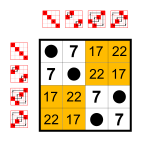 |
 |
 |
| Cycle graphs | |||||||
|---|---|---|---|---|---|---|---|
|
Order 3
[edit | edit source] |
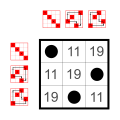 |
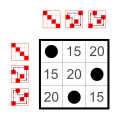 |
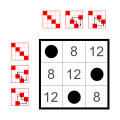 |
| Cycle graphs | ||||
|---|---|---|---|---|
|
The subgroups of every group form a lattice:
The permutations of n elements form a lattice.
A permutation may be defined by its set of inversions;
and the lattice by the subset relation between these sets.
Or a permutation my be defined by its factorial number (or inversion vector);
and the lattice by the bitwise less than or equal relation between them.
Permutohedron
[edit | edit source]The Hasse diagram of the weak order of permutations is the permutohedron. For the symmetric group S4 it's the truncated octahedron.
 |
 |
 |
 |
 |
 and inversion vectors below them (compare convex version) |

 The edges of the permutohedron match transpositions, i.e. permutations exchanging only two elements.
The edges of the permutohedron match transpositions, i.e. permutations exchanging only two elements.When two permutations are linked by a highlighted edge, representing one of six transpositions,
this transposition turns one permutation into the other and vice versa.
E.g. in the top permutohedron the permutations 3 and 5 are linked by a highlighted edge, representing transposition 2.
So 2∘3=5 and 2∘5=3. The Function composition g∘f (spoken "g of f" or "g after f") tells, that first f is done, and then g.

 and
and  above, but with a single permutohedron for each inversion.
above, but with a single permutohedron for each inversion.The highlighted edges from the file above are also shown.
A vertex is red , when it's higher than such an edge - i.e. when an arrow points in its direction directly or indirectly.
The red vertices always form a compound of two hexagons and two squares.
If one wants to have join and meet of any two permutations, one can find them in the permutohedron. The following table shows all relevant pairs of permutations. The arguments (row and column of the table) and their join and meet are shown by red vertices in the little permutohedra. The highest red vertex is always the join and the lowest red vertex is the meet . ![]()
| Join and meet in permutohedra |
|---|
 |
The following join table is derived from the table above. Besides the decimal enumeration, it shows also the inversion sets and factorial numbers. (The meet table is like this one, but reflected about the subdiagonal, and with all numbers replaced by their difference with 23.)


It's worth taking a look at the number of red squares in the 24 matrices above:
The table becomes more interesting, looking only at the inversion bits. This file shows the bits of every inversion in a single matrix:

One can see, that for the three inversions comparing consecutive places, the join operation is simply the union of the inversion sets. For the two inversions comparing places with one place between, there are 32 darker red fields beyond the union. For the inversion comparing the first and the last place, there are 56 darker fields beyond the union. So the union of two permutations inversion sets is always a subset to the inversion set of the permutations' join.
A closer look at the Cayley table
[edit | edit source]| The Cayley table again |
|---|
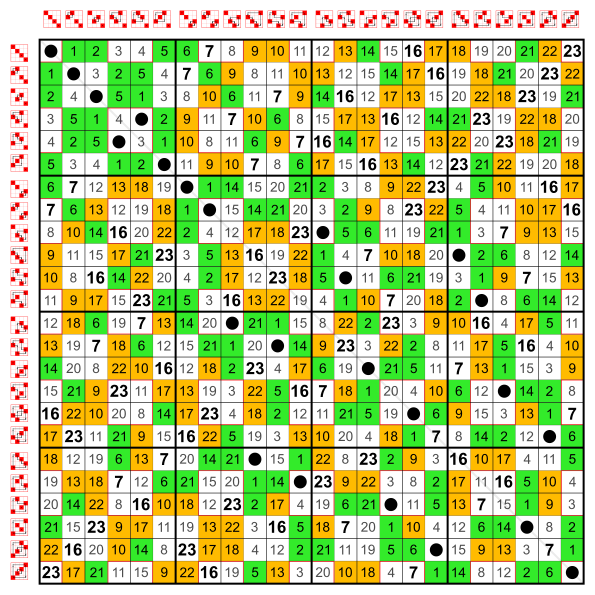 |
Every entry appears exactly one time in every row and column of the Cayley table.
So the positions of the entries form 24 permutation matrices:

Rows and columns of the Cayley table match permutations of 24 elements.
Below they are also represented as permutation matrices:


Generators and Cayley graphs
[edit | edit source]Rhombicuboctahedron - Generators 4, 9 or (132), (1234)
[edit | edit source] |
 |
 |

Truncated cube - Generators 1, 8 or (12), (234)
[edit | edit source] |
 |
Generators 1, 9 or (12), (1234)
[edit | edit source] |
 |
Generators 1, 2, 6 or (12), (23), (34)
[edit | edit source] |
 |
 |
| Cayley graph and permutohedron | ||||
|---|---|---|---|---|
|

Nauru graph - Generators 1, 5, 21 or (12), (13), (14)
[edit | edit source]Torus embedding
[edit | edit source] |
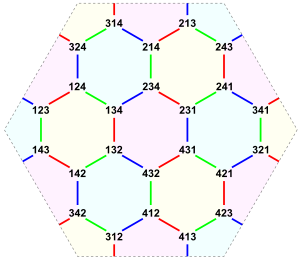 Triples linked by an edge differ in only one digit. The edge color tells by which: 1st, 2nd, 3rd |
 |
 |
 |
 |
Adjacency matrix
[edit | edit source]
Bit permutations
[edit | edit source]When the permutations pn of 4 elements are applied on the reverse binary digits of the integers 0...15,
they generate permutations Pn of 16 elements, which also form the symmetric group S4.![]() Walsh permutation; bit permutation
Walsh permutation; bit permutation

 Cycle graphs of S4 with permutations pn and Pn
Cycle graphs of S4 with permutations pn and PnGray code order (Steinhaus–Johnson–Trotter algorithm)
[edit | edit source]| The algorithm defines a Hamiltonian path in a Cayley graph of the symmetric group. The inverse permutations define a path in the permutohedron: |  |
 |
 |
 |
 |
| Permutations with green or orange background are odd. Numbers in boldface type are double-transpositions. The smaller numbers below the permutations are the inversion vectors. Red marks indicate swapped elements. | |







































